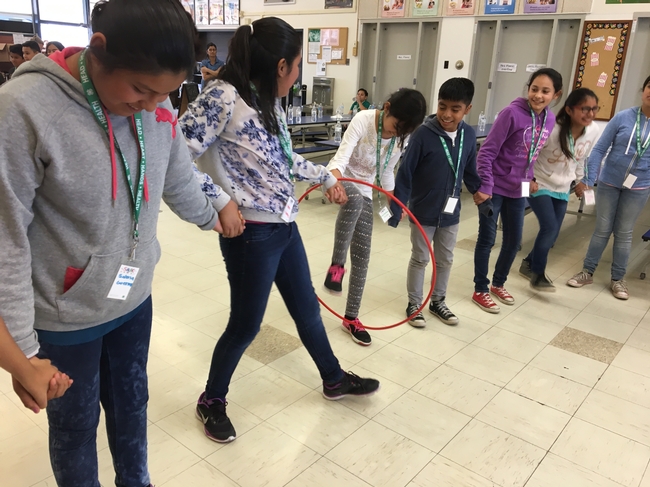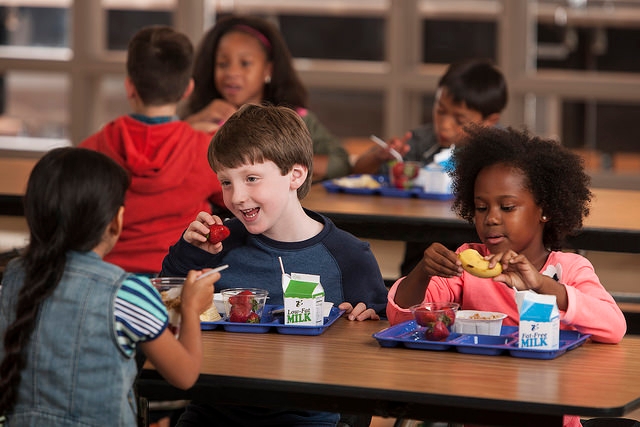
Posts Tagged: lunch
Why I'm the cupcake police

In the morning you hurry to put your clothes on, brush your hair, brush your teeth and get everything in your school bag for the day. Dad needs to drop you off at school at 7:30 a.m. so he can get to work on time. You grab a bag of chips as you run out the door, rubbing your eyes and looking to make sure you didn't put your shirt on backwards again.
Somewhere around 10:00 a.m. your tummy starts to growl. You feel your mouth start to water a little and your eyes droop. Looking at the clock you count the minutes until lunch. At 11:25 , one of your classmate's parents comes in with a tray of cupcakes to celebrate her birthday! Your stomach jumps at the sight of pink butter cream frosting piled high on the little cakes. Your teacher hands one to each student in the class and you savor every delicious bite.
Fifteen minutes later the lunch bell rings. Your teacher walks everyone over to the cafeteria and you get in line for school lunch. You feel embarrassed to eat school lunch and since you ate that cupcake you're not really hungry anyway. You plop a few things on your plate making a face. Sitting down you pick at the food until the custodian says you can get up and go play. You dump your tray with most of the food still on it and run outside chasing your friends onto the blacktop.
Back in class you feel energized after your game of handball. Your face is red and you're a little sweaty from all the running around. Your teacher announces that your group won the weekly contest and each of you will get to pick from the candy bag. That sounds great to you because you are starting to get hungry again. You put a few pieces of candy in your mouth. You get back to work on your math problem but it's the afternoon and you always have trouble concentrating in the afternoon…
Maggie is just one of more than 30 million children in the U.S. who qualify for free or reduced-price school meals through the USDA school meal program. Students like Maggie may rely on food at school for up to 50 percent of their daily calories and school meals represent a larger portion of the school-day caloric and nutrient intake for food insecure children. In addition, research shows that income level, educational attainment and family composition impact diet quality and physical activity.
The national school lunch program, while not perfect, is intended to ensure students like Maggie are offered a variety of fruits and vegetables and whole-grain rich foods every day. There are limits to the amount of sodium, saturated fat, trans-fat and calories that are offered as part of a school meal. Studies have shown that child nutrition programs improve diet quality and academic performance for children in low-income and food-insecure households.[1]
When we offer our children and students food with little to no nutritional quality for a reward and cupcakes to celebrate a birthday, we are impacting their overall dietary quality for the day. For Maggie, the problem is compounded by the fact that she does not have access to a varied and nutritious diet at home. She has nothing to fall back on when she doesn't get a nutritious meal at school and she fills up on empty calories instead. Childhood is an important time when people develop lifelong eating and physical activity patterns.
So when I am faced with the dilemma, once again, of speaking up and being the cupcake police or staying silent and going along with treats at school, I think of Maggie.
What can you do to create healthier schools for all children:
- Look up your School Wellness Policy. Every school that participates in the School Meal Program has one. However, many times they were written and never revisited. Check your district web page or go to the Dairy Council finder. School Wellness Policies outline what is and is not allowed to be offered in the classroom or fundraisers during school.
- Offer non-food rewards for positive behaviors: Extra physical activity time or recess, the opportunity to eat lunch in the cafeteria with the teacher, special privileges like “line leader” for the day, or the opportunity to go out to the garden. For more healthy reward ideas visit Healthy Food Choices in Schools.
- Celebrations that reinforce health: Include physical activity like a dance party in your celebration (see GoNoodle for all kinds of fun activities and brain breaks), ask parents to bring in a donated book for the class instead of cupcakes (see Books for Birthdays), if you are going to have food, make sure non-nutritious items are limited to one per student.
- Eat lunch with your student(s): If you're a parent, check-in with your school. Many schools allow parents to eat lunch with their children if notified in advance. If you're a teacher, eating with your students is a great way to teach and model healthy eating behaviors. Interested in learning more about the importance of school meals? Find out here.
- Is the school offering a variety of fruits and vegetables? Can the students all see the food and serve it safely? Are any local foods available? If not, set a meeting with the Food Service staff to discuss your ideas and see how you can help.
[1] https://www.ers.usda.gov/webdocs/publications/84003/eib-174_summary.pdf?v=42905
Nutrition Policy Institute study highlights benefits of school lunch
Lunches served in the National School Lunch Program have higher nutritional quality than lunches brought from home, according to the largest comparison study conducted to date.
Published in the November 2016 issue of the Journal of the Academy of Nutrition and Dietetics, the study, conducted by researchers at UC's Nutrition Policy Institute, involved nearly 4,000 elementary school students in Southern California.
“This rigorous study confirms what we have long known: The school lunch program, which has served the country's students since 1946, makes an invaluable contribution to their nutritional well-being, their health and their academic performance," said Lorrene Ritchie, Ph.D., director of the Nutrition Policy Institute and a senior author of this study. "And thanks to the recent, improved nutrition standards, it will only provide stronger, more essential support for our children's success.”
School lunch consumption was associated with higher overall diet quality. School lunch eaters also consumed diets that were higher in dairy-rich foods, lower in empty calories from solid fats and added sugars, and lower in refined grains than students who ate lunches from home.
Established in 1946, the National School Lunch Program is a federal nutrition assistance program that provides nutritionally balanced, low-cost or free lunches in over 100,000 K-12 schools throughout the United States. School lunches are required to meet certain nutrition standards based on the latest Dietary Guidelines for Americans. New requirements increase the availability of fruits, vegetables and whole grains and reduce sodium and fat in school lunches. Guidelines on calorie limits are set to ensure age-appropriate sized meals for grades K-5, 6-8 and 9-12.
During the 2014-15 school year, the program served lunches to about 30.5 million children each school day. More than 21.5 million of these students qualified for free or reduced-price service. Given the program's broad reach and its targeting of low-income children, the nutritional improvements shown in this study are of considerable benefit to needy students for whom school lunch may represent roughly one-third of their daily calories.
Since the study was conducted, new and more rigorous nutritional standards have been implemented, thus increasing the likelihood that school lunches are contributing to healthy overall diets – and reversing the extremely worrisome obesity epidemic. Currently as many as one-third of U.S. youth are obese or overweight.
Get an 'A' in back-to-school nutrition
During summer break, healthy food and fitness often take a long vacation. For many, the vacation is ending and it's time to do some homework. Study these back-to-school tips for the start to a healthy school year. If you follow a balanced diet and stay physically active, there's no way you can't get an 'A' in back-to-school nutrition!
- Don't skip breakfast! Studies show children who eat breakfast perform better in school.
- If you pack a homemade lunch for your children, include a good balance of fruits, vegetables, whole grains, low-fat or fat free dairy products, and lean meats and proteins.
- Provide new options! Pack exotic fruits like kiwi or allow your child to pick a fun new fruit or vegetable at the grocery store. They are more likely to eat their lunch if they helped prepare it.
- Reinforce cleanliness and remind your children to wash their hands before they eat or pack a moist towelette or hand sanitizer in their lunchbox.
- Physical activity and exercise are important and help improve a child's health. Children should be active for at least 60 minutes a day, and adults need to be active for at least 30 minutes a day. Make exercise a family affair and get the physical activity everyone needs! Go for a weekend hike, walk the dog together, or ride your bikes after dinner.
Try this quick and easy recipe for your child's lunch or mix it up and substitute a variety of their favorite vegetables instead.
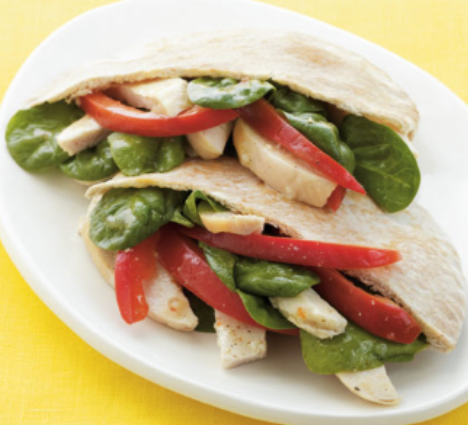
Ingredients:
- 1 cup baby spinach
- 4 ounces cooked skinless, boneless chicken
- 1/2 cup sliced red bell pepper
- 2 tablespoons low-fat Italian vinaigrette
- 1 (6-inch) whole-grain pita, cut in half
Directions:
- Combine spinach, chicken, bell pepper, and vinaigrette in a bowl; lightly toss and mix ingredients.
- Cut the pita pieces in half.
- Using a spoon, fill each pita half with the tossed ingredients.
- Once assembled, lay them flat and pack them up for your child to enjoy during lunch.
Recipe source: http://www.health.com/health/recipe/0,,10000001983452,00.html
A big bowl of dark leafy greens and ...
We all know that eating dark leafy greens is good for us, right? So that’s why for lunch lately I’ve been on a health kick to eat a big bowl of dark leafy greens topped with a lean protein source. I have, however, been subject to some good-natured ribbing around my office regarding my lunch selections. So I decided to research my lunch ingredients, and why I, as well as my inquisitive co-workers, already know it’s something of a power lunch, in the most nutritious of ways. First, the base of my lunch: a mix dark leafy greens (today it’s spinach, baby bok choy, and red and green chard).
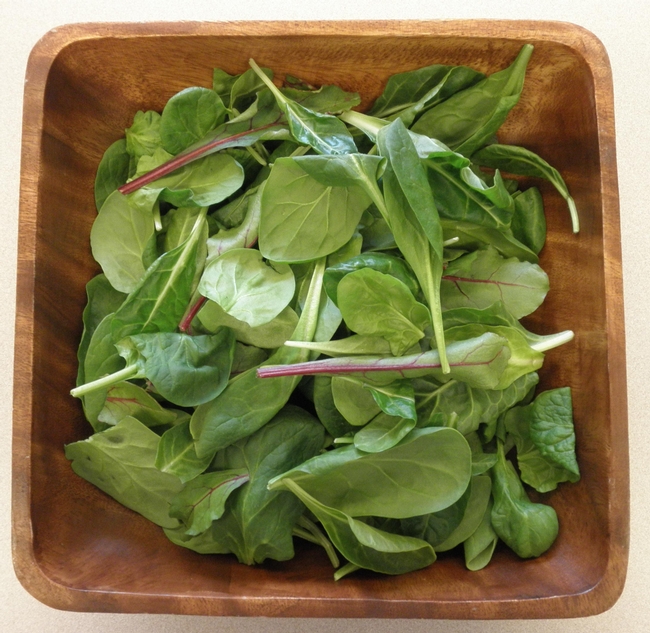
The USDA describes the following general health benefits by eating your vegetables:
- Eating a diet rich in vegetables and fruits as part of an overall healthy diet may reduce risk for heart disease, including heart attack and stroke.
- Eating a diet rich in some vegetables and fruits as part of an overall healthy diet may protect against certain types of cancers.
- Diets rich in foods containing fiber, such as some vegetables and fruits, may reduce the risk of heart disease, obesity, and type 2 diabetes.
- Eating vegetables and fruits rich in potassium as part of an overall healthy diet may lower blood pressure, and may also reduce the risk of developing kidney stones and help to decrease bone loss.
- Eating foods such as vegetables that are lower in calories per cup instead of some other higher-calorie food may be useful in helping to lower calorie intake.
And specifically, dark leafy greens are nutrition-dense, with loads of vitamins (Vitamin K, C, E and B), minerals (iron, potassium, magnesium and calcium) and fiber. Additionally they contain beta-carotene, lutein and zeaxanthin, which aide in disease prevention.
Second, the toppings. I’ve left this part for the end, because those co-workers of mine thought you might not still be reading if I let you in on my super power lunch protein choice, so here it is: a can of herring.
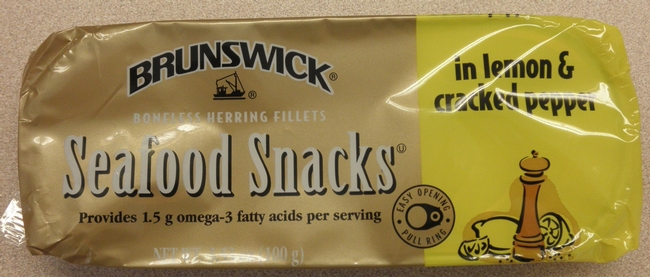
Surprised? Yep, herring is really good (I already like herring, but I love the lemon pepper variety), and there’s no need to add dressing, just dump the whole can on your salad! Sardines, smoked oysters and tuna — all on the “Good alternative” or “Best Choice” list on the Monterey Bay Aquarium Seafood Watch — are also delicious. They’re also very convenient and relatively inexpensive, especially if you stock up when they’re on sale. Fish is a super-food of protein choices, evidenced by the USDA Dietary Guidelines for Americans 2010:
“Mean intake of seafood in the United States is approximately 3 1/2 ounces per week, and increased intake is recommended. Seafood contributes a range of nutrients, notably the omega-3 fatty acids, eicosapentaenoic acid (EPA) and docosahexaenoic acid (DHA). Moderate evidence shows that consumption of about 8 ounces per week of a variety of seafood, which provide an average consumption of 250 mg per day of EPA and DHA, is associated with reduced cardiac deaths among individuals with and without pre-existing cardiovascular disease.”
A recent USDA paper says fish consumption is especially beneficial to pregnant and lactating women: “increased maternal dietary intake of long chain omega-3 fatty acids, in particular DHA from at least two servings of seafood per week during pregnancy and lactation is associated with increased DHA levels in breast milk and improved infant health outcomes, such as visual acuity and cognitive development.” (See complete February 2012 article.) And, just as I was getting ready to submit my blog, an article entitled “Brainpower Tied to Omega-3 Levels” appeared in the NY Times. How’s that for timing!
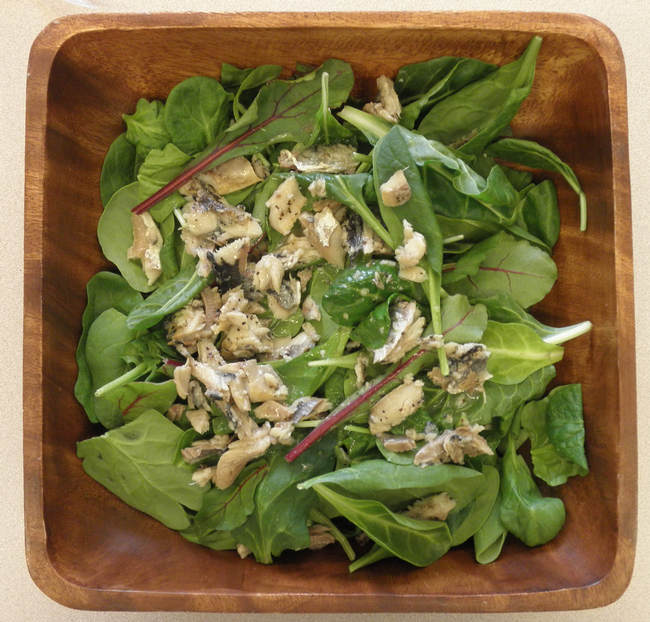
All this is not to say that chicken breast, tofu or beans are to scoff at, but do you get your USDA-recommended two servings of fish a week? What about that recommended two servings of chicken breast? Or tofu? Even beans don’t get a mention of how many times a week you should eat them. And for this I get razzed by my co-workers. Hmmph—bon appetite!
Farm-to-school movement gains momentum
UC Davis is riding high on a swell of interest in changing the way American children eat. First lady Michelle Obama, celebrity chef Alice Waters and TV personality Jamie Oliver are behind the spiking popularity of a movement that has been quietly building for years in places like UC Davis, which founded the Davis Farm to School Connection in 2000.
Last week, school nutritionists, farmers and others in the agriculture industry - including UC Cooperative Extension - gathered for a workshop aimed at making farm-to-school a reality in Yuba County, according to an article in yesterday's Appeal-Democrat.
The story centered on UC Davis student Julia Van Soelen Kim, who decided to make the farm-to-school food movement the topic of her master's degree thesis. She helped coordinate last Thursday's workshop, and plans to serve as a farm-to-school researcher.
A school nutrition services director, Mary Driscoll, of the Marysville school district, raised a common concern about the movement at the workshop.
"It's a little more costly, but we are willing to pay that if we can stay within our budget," Driscoll was quoted. And, she said, it has to be consistent.
Van Soelen Kim acknowledged that farm-to-school food is "easier said than done," noting that successful long-term implementation requires buy-in from school administrators, local government officials and farmers.
But the benefits are many. Such programs improve children's health, teach kids where their food comes from and support the local economy, the article said. They also reduce the resources used to process, package and transport food.

Bringing local foods into school cafeterias offers many benefits.


